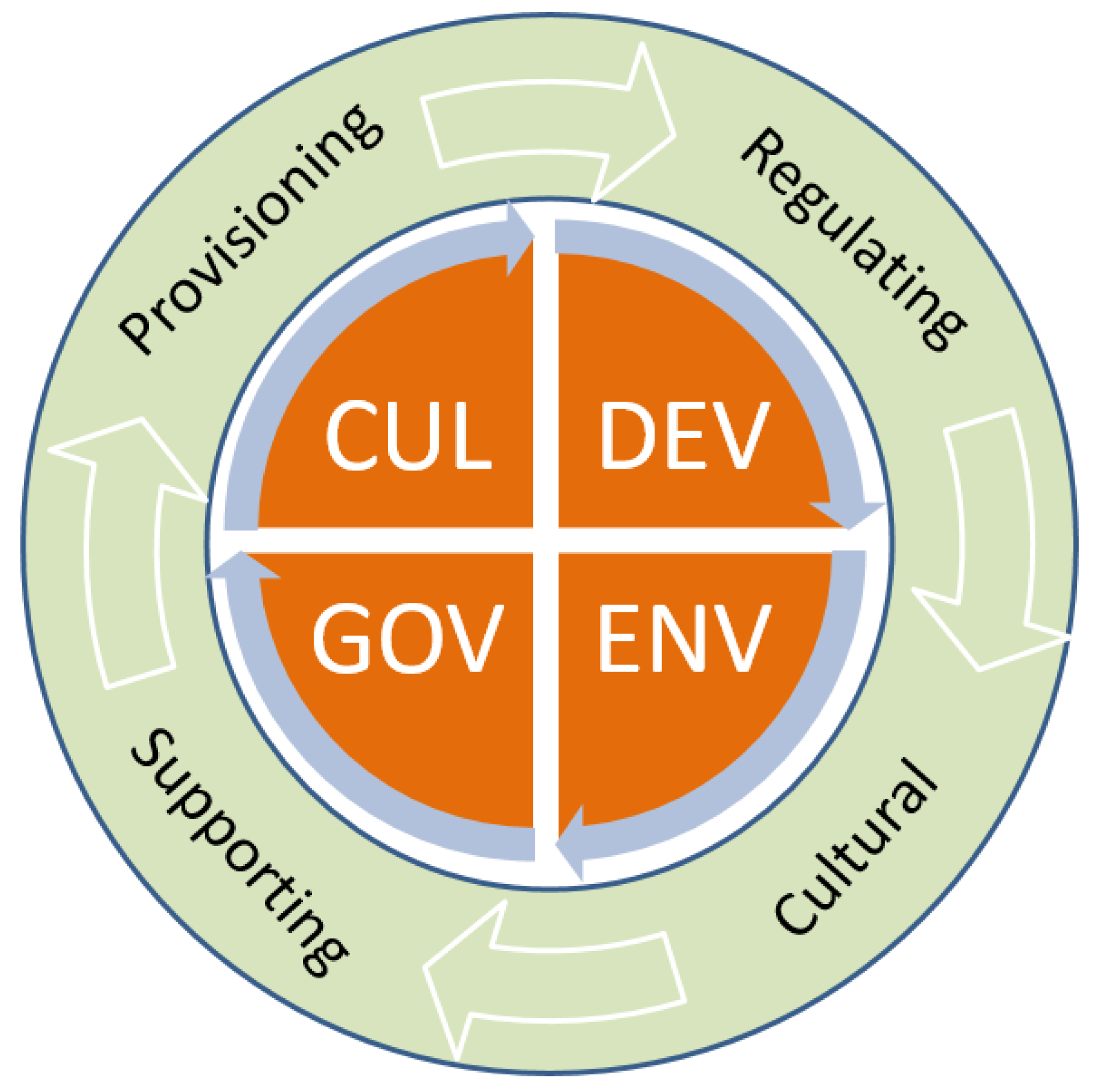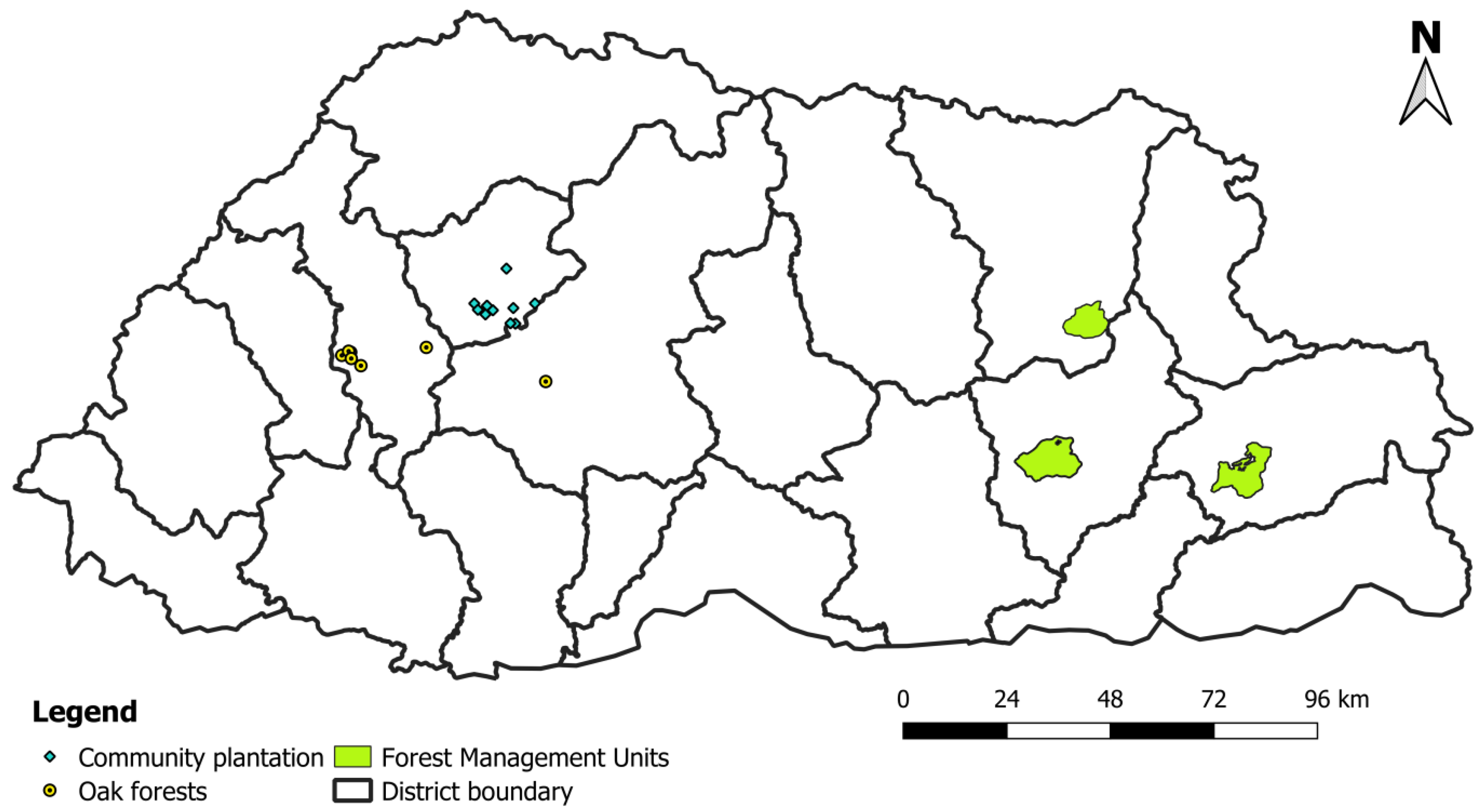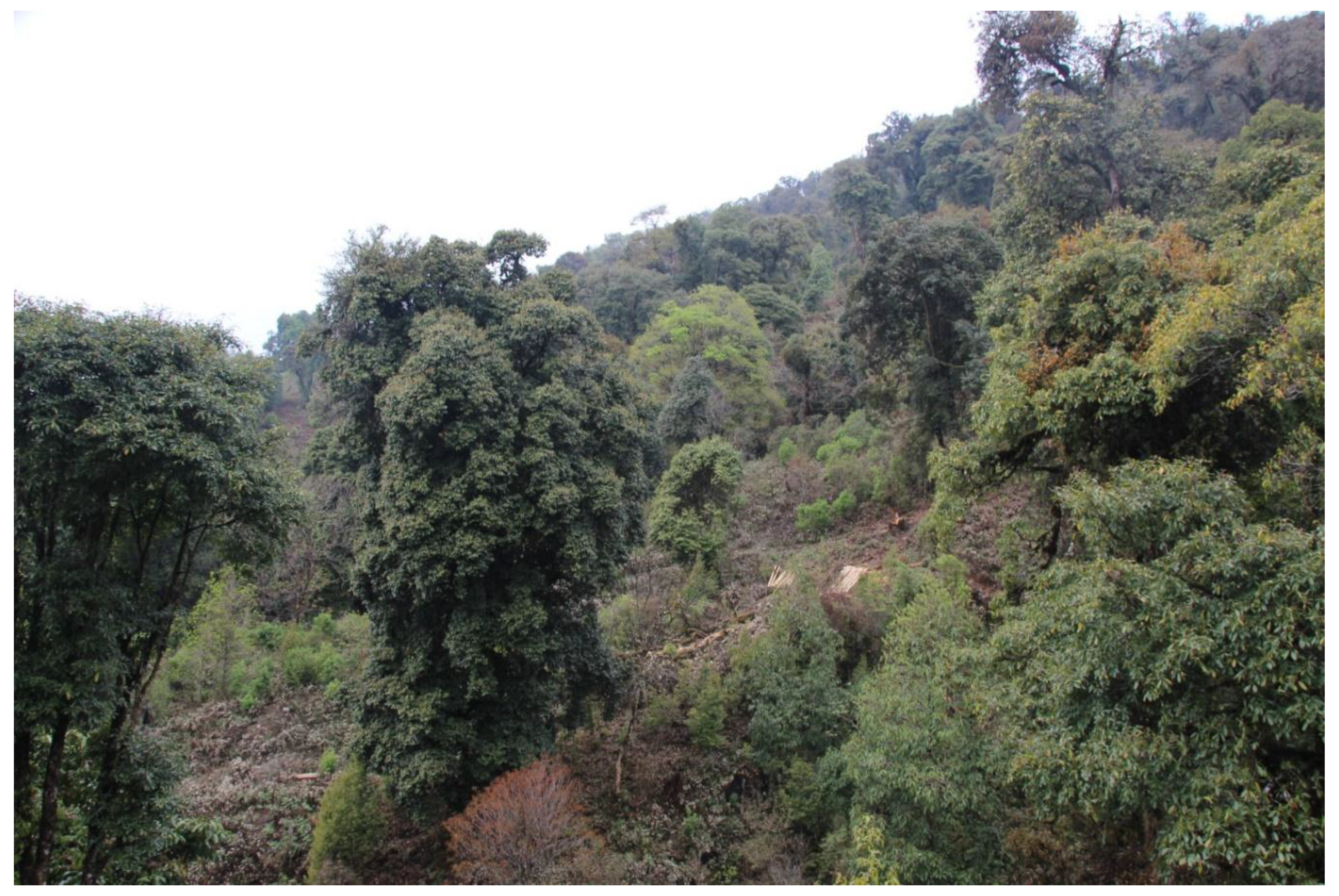Bhutan’s Forests through the Framework of Ecosystem Services: Rapid Assessment in Three Forest Types
Abstract
1. Introduction
2. Forest Ecosystem Services in Mountain Ecosystems
3. Perceptions of the Ecosystem Services of Three Forests
3.1. High–Altitude Oak Forests
3.2. Community Plantations
3.3. Forest Management Units
4. Discussion
5. Conclusions
Author Contributions
Funding
Acknowledgments
Conflicts of Interest
References
- Kubiszewski, I.; Costanza, R.; Dorji, L.; Thoennes, P.; Tshering, K. An initial estimate of the value of ecosystem services in Bhutan. Ecosyst. Serv. 2013, 3, e11–e21. [Google Scholar] [CrossRef]
- Reed, J.; van Vianen, J.; Foli, S.; Clendenning, J.; Yang, K.; MacDonald, M.; Petrokofsky, G.; Padoch, C.; Sunderland, T. Trees for life: The ecosystem service contribution of trees to food production and livelihoods in the tropics. For. Policy Econ. 2017, 84, 62–71. [Google Scholar] [CrossRef]
- Sidle, R.C.; Ziegler, A.D.; Negishi, J.N.; Nik, A.R.; Siew, R.; Turkelboom, F. Erosion processes in steep terrain—Truths, myths, and uncertainties related to forest management in Southeast Asia. For. Ecol. Manag. 2006, 224, 199–225. [Google Scholar] [CrossRef]
- Hartanto, H.; Prabhu, R.; Widayat, A.S.E.; Asdak, C. Factors affecting runoff and soil erosion: Plot-level soil loss monitoring for assessing sustainability of forest management. For. Ecol. Manag. 2003, 180, 361–374. [Google Scholar] [CrossRef]
- Hoy, A.; Katel, O.; Thapa, P.; Dendup, N.; Matschullat, J. Climatic changes and their impact on socio-economic sectors in the Bhutan Himalayas: An implementation strategy. Reg. Environ. Chang. 2016, 16, 1401–1415. [Google Scholar] [CrossRef]
- Sharma, E.; Chettri, N.; Tsering, K.; Shrestha, A.B.; Jing, F.; Mool, P.; Eriksson, M. Climate Change Impacts and Vulnerability in the Eastern Himalayas; ICIMOD: Kathmandu, Nepal, 2009. [Google Scholar]
- Xu, J.; Grumbine, E.E.; Shrestha, A.; Eriksson, M.; Yang, X.; Wang, Y.; Wilkes, A. The melting Himalayas: Cascading effects of climate change on water, biodiversity, and livelihoods. Conserv. Biol. 2009, 23, 520–530. [Google Scholar] [CrossRef] [PubMed]
- Sharma, E.; Chettri, N.; Prasad Olik, K. Mountain biodiversity conservation and management: A paradigm shift in policies and practices in the Hindu Kush-Himalayas. Ecol. Res. 2010, 25, 90–923. [Google Scholar] [CrossRef]
- Buttoud, G. Multipurpose management of mountain forests: Which approaches? For. Policy Econ. 2002, 4, 83–87. [Google Scholar] [CrossRef]
- Weiss, G. Mountain forest policy in Austria: A historical policy analysis on regulating a natural resource. Environ. Hist. 2001, 7, 335–355. [Google Scholar] [CrossRef]
- Ministry of Agriculture and Forests. National Forest Inventory Report: Stocktaking Nation′s Forest Resources; (FRMD) Forest Resources Management Division, Department of Forests and Park Services, Ministry of Agriculture and Forests: Thimphu, Bhutan, 2016.
- Department of Revenue & Customs. National Revenue Report 2016–2017; Ministry of Finance, Royal Government of Bhutan: Thimphu, Bhutan, 2017.
- Gurung, D.B.; Seeland, K. Ecotourism in Bhutan—Extending its benefits to rural communities. Ann. Tour. Res. 2008, 35, 489–508. [Google Scholar] [CrossRef]
- Nkonya, E.; Srinivasan, R.; Anderson, W.; Kato, E. Economics of land degradation and improvement in Bhutan. In Economics of Land Degradation and Improvement—A Global Assessment for Sustainable Development; Nkonya, E., Mirzabaev, A., von Braun, J., Eds.; Springer International Publishing: Cham, Switzerland, 2016; pp. 327–383. [Google Scholar]
- Wangdi, T.; Lhendup, P.; Wangdi, N. An Analysis of Forestry Policy, Acts and Rules of Bhutan to Mainstream Climate Change Adaptation. Regional Climate Change Adaptation; Stockholm Environment Institute: Bangkok, Thailand, 2013. [Google Scholar]
- Royal Government of Bhutan. National Forest Policy of Bhutan (Draft, Post-Regional Consultations Sept 2008); Ministry of Agriculture: Thimphu, Bhutan, 2011.
- Sears, R.R.; Phuntsho, S.; Dorji, T.; Choden, K.; Norbu, N.; Baral, H. Forest Ecosystem Services and the Pillars of Bhutan′s Gross National Happiness; Center for International Forestry Research (CIFOR): Bogor, Indonesia, 2017. [Google Scholar]
- Moktan, M.R.; Norbu, L.; Choden, K. Can community forestry contribute to household income and sustainable forestry practices in rural area? A case study from Tshapey and Zariphensum in Bhutan. For. Policy Econ. 2016, 62, 149–157. [Google Scholar] [CrossRef]
- Phuntsho, S.; Schmidt, K.; Kuyakanon, R.S.; Temphel, K.J. Community Forestry in Bhutan: Putting People at the Heart of Poverty Reduction; Ugyen Wangchuck Institute for Conservation and Environment and Social Forestry Division: Jakar/Thimphu, Bhutan, 2011. [Google Scholar]
- Sangay, T.; Vernes, K. The economic cost of wild mammalian carnivores to farmers in the Himalayan Kingdom of Bhutan. J. Bhutan Ecol. Soc. 2014, 1, 98–111. [Google Scholar]
- World Wildlife Fund for Nature. Valuing Ecosystem Services in Chamkharchhu Sub Basin: Mapping Sediment Using InVEST; World Wildlife Fund for Nature: Thimphu, Bhutan, 2017. [Google Scholar]
- Wangdi, S.; Norbu, N.; Wangchuk, S.; Thinley, K. Social restriction in traditional forest management systems and its implications for biodiversity conservation in Bhutan. J. Bhutan Ecol. Soc. 2015, 1, 112–122. [Google Scholar]
- Dorji, U.; Olesen, J.E.; Seidenkrantz, M.S. Water balance in the complex mountainous terrain of Bhutan and linkages to land use. J. Hydrol. 2016, 7, 55–68. [Google Scholar] [CrossRef]
- Baral, H.; Keenan, R.J.; Stork, N.E.; Kasel, S. Measuring and managing ecosystem goods and services in changing landscapes: A south-east Australian perspective. J. Environ. Plan. Manag. 2014, 57, 961–983. [Google Scholar] [CrossRef]
- Paudyal, K.; Baral, H.; Burkhard, B.; Bhandari, S.P.; Keenan, R.J. Participatory assessment and mapping of ecosystem services in a data-poor region: Case study of community-managed forests in central Nepal. Ecosyst. Serv. 2015, 13, 81–92. [Google Scholar] [CrossRef]
- Baral, H.; Jaung, W.; Bhatta, L.D.; Phuntsho, S.; Sharma, S.; Paudyal, K.; Zarandian, A.; Sears, R.R.; Sharma, R.; Dorji, T.; et al. Approaches and Tools for Assessing Mountain Forest Ecosystem Services; Center for International Forestry Research (CIFOR): Bogor, Indonesia, 2017; Volume Working Paper, 235. [Google Scholar]
- Shrestha, B.B. Quercus semecarpifolia Sm. in the Himalayan region: Ecology, exploitation and threats. Himal. J. Sci. 2003, 1, 126–128. [Google Scholar] [CrossRef]
- Singh, A.K.; Pande, R.K. Changes in spring activity: Experiences of Kumaun Himalaya, India. Environmentalist 1989, 9, 25–29. [Google Scholar] [CrossRef]
- Singh, S.P.; Singh, J.S. Structure and function of the central Himalayan oak forests. Plant Sci. 1986, 96, 159–189. [Google Scholar]
- Tashi, S.; Thinley, C. Regeneration of brown oak (Quercus semecarpifolia Sm.) in an old growth oak forest. RNR J. Bhutan 2008, 4, 11–23. [Google Scholar]
- Dorji, T. Regeneration of Dominant Tree Species in A Temperate Broadleaf Forest of Bhutan Himalayas with Special Reference to Grazing and Fencing. Master’s Thesis, The University of Tokyo, Tokyo, Japan, 2012. [Google Scholar]
- Brockerhoff, E.G.; Jactel, H.; Parrotta, J.A.; Quine, C.P.; Sayer, J. Plantation forests and biodiversity: Oxymoron or opportunity? Biodivers. Conserv. 2008, 17, 925–951. [Google Scholar] [CrossRef]
- Paquette, A.; Messier, C. The role of plantations in managing the world′s forests in the Anthropocene. Front. Ecol. Environ. 2009, 8, 27–34. [Google Scholar] [CrossRef]
- Pirard, R.; Petit, H.; Baral, H. Local impacts of industrial tree plantations: An empirical analysis in Indonesia across plantation types. Land Use Policy 2017, 60, 242–253. [Google Scholar] [CrossRef]
- Bremer, L.L.; Farley, K.A. Does plantation forestry restore biodiversity or create green deserts? A synthesis of the effects of land-use transitions on plant species richness. Biodivers. Conserv. 2010, 19, 3893–3915. [Google Scholar] [CrossRef]
- Lazos-Chavero, E.; Zinda, J.; Bennett-Curry, A.; Balvanera, P.; Bloomfield, G.; Lindell, C.; Negra, C. Stakeholders and tropical reforestation: Challenges, trade-offs, and strategies in dynamic environments. Biotropica 2016, 48, 900–914. [Google Scholar] [CrossRef]
- Norbu, L.; Dhital, D.B.; Wangda, P. Reforestation in Bhutan—Accomplishments and prospects. In Keep Asia Green III “South Asia”; IUFRO: Vienna, Austria, 2008; Volume 20-III, pp. 67–109. [Google Scholar]
- Social Forestry and Extension Division. Plantation Record of Bhutan; Department of Forest and Parks Services, Royal Government of Bhutan: Thimphu, Bhutan, 2017. [Google Scholar]
- Maerki, D. Which Latin name for Tsenden? Bull. Cupressus Conserv. Proj. 2013, 2, 39–71. [Google Scholar]
- Moktan, M.R. Impacts of recent policy changes on rural communities and species diversity in government-managed forests of western Bhutan. Mt. Res. Dev. 2010, 30, 365–372. [Google Scholar] [CrossRef]
- Kusters, K.; Wangdi, N. The costs of adaptation: Changes in water availability and farmers’ responses in Punakha District, Bhutan. Int. J. Glob. Warm. 2013, 5, 387–399. [Google Scholar] [CrossRef]
- Shrestha, U.B.; Gautam, S.; Bawa, K.S. Widespread climate change in the Himalayas and associated changes in local ecosystems. PLoS ONE 2012, 7, e36741. [Google Scholar] [CrossRef] [PubMed]
- Millennium Ecosystem Assessment. Ecosystems and Human Well-Being: A Framework for Assessment; Island Press: Washington, DC, USA, 2003. [Google Scholar]
- Gilmour, D. Forests and Water: A Synthesis of the Contemporary Science and Its Relevance for Community Forestry in the Asia-Pacific Region; RECOFT—The Center for People and Forests: Bangkok, Thailand, 2014. [Google Scholar]



| Service/Site | Oak Forest | FMU Forest | Plantation Forest |
|---|---|---|---|
| Provisioning | Fresh water (Highest) Timber (High) Fuel wood (High) NWFP (Medium) Fodder (Low) Leaf litter (Low) | Fresh water (High) Timber (High) Boulder (Medium) | Leaf litter (High) Fodder collection (High) Flag pole (Low) |
| Regulating | Soil erosion protection (Low) Fresh air (Low) Groundwater recharge (Low) Wind break (Low) | Land productivity (Highest) Fresh air (Medium) Carbon sequestration (Low) Local weather regulation (Low) | Soil erosion protection (High) Improved vegetation cover (Low) Reduced forest fire incidence (Low) |
| Supporting | Wildlife habitat (Low) Biodiversity (Low) | Pollination (Low) | Wildlife habitat (Low) |
| Cultural | Spiritual sites (High) Recreation (Low) Aesthetic (Low) | Spiritual sites (Low) | Aesthetic (Low) |
© 2018 by the authors. Licensee MDPI, Basel, Switzerland. This article is an open access article distributed under the terms and conditions of the Creative Commons Attribution (CC BY) license (http://creativecommons.org/licenses/by/4.0/).
Share and Cite
Sears, R.R.; Choden, K.; Dorji, T.; Dukpa, D.; Phuntsho, S.; Rai, P.B.; Wangchuk, J.; Baral, H. Bhutan’s Forests through the Framework of Ecosystem Services: Rapid Assessment in Three Forest Types. Forests 2018, 9, 675. https://doi.org/10.3390/f9110675
Sears RR, Choden K, Dorji T, Dukpa D, Phuntsho S, Rai PB, Wangchuk J, Baral H. Bhutan’s Forests through the Framework of Ecosystem Services: Rapid Assessment in Three Forest Types. Forests. 2018; 9(11):675. https://doi.org/10.3390/f9110675
Chicago/Turabian StyleSears, Robin R., Kinley Choden, Tshewang Dorji, Dorji Dukpa, Sonam Phuntsho, Prem Bahadur Rai, Jigme Wangchuk, and Himlal Baral. 2018. "Bhutan’s Forests through the Framework of Ecosystem Services: Rapid Assessment in Three Forest Types" Forests 9, no. 11: 675. https://doi.org/10.3390/f9110675
APA StyleSears, R. R., Choden, K., Dorji, T., Dukpa, D., Phuntsho, S., Rai, P. B., Wangchuk, J., & Baral, H. (2018). Bhutan’s Forests through the Framework of Ecosystem Services: Rapid Assessment in Three Forest Types. Forests, 9(11), 675. https://doi.org/10.3390/f9110675






